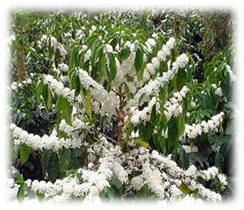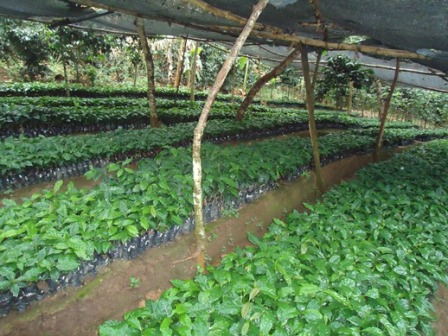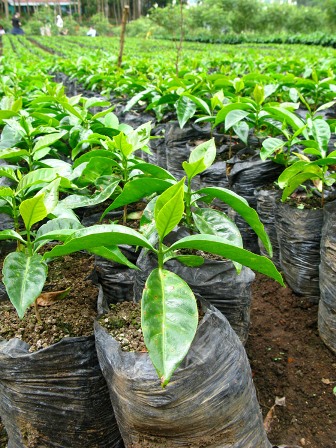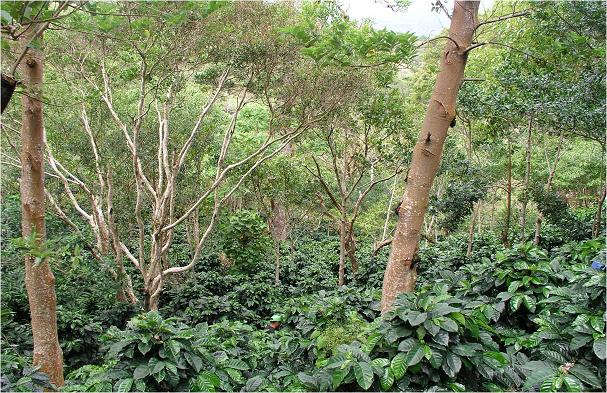Soil and climate
Soil should be deep, friable, open textured rich in
plant nutrients with plenty of humus and of slightly acidic nature (pH –
4.5 to 6.5)
Varieties
Elevation (m)
Rainfall (mm)
Distribution
Robusta
500 – 1000
1000 - 2000
Blossom shower – February - March
Arabica
1000 - 1500
1600 - 2500
Blossom shower – March - April
Backing shower during April – May is required for both the varieties
Seeds and sowing
Coffee is propagated by seeds
Season
Planting spreads from June - December
Preparation of seeds
Healthy and well developed fully ripe berries are
harvested from specially identified plants for use as seed bearers.
After discarding the floats, the sound fruits are depulped, sieved and
mixed with sieved wood ash and dried in shade. The seed is then graded
to remove all cut, triangular and elephant beans. Prior to planting,
the seeds are treated with Agrosan or any Organomercurial compound to
prevent fungal infection.
Nursery practices
Select light loamy soil of good drainage with high
organic matter content with water and shade facilities. Form raised
beds of 15 cm height, 1m width and at convenient length. Incorporate
30 - 40 kg of well rotten compost, 2 kg of finely sieved agricultural
lime and 400 g of rock phosphate to a bed of 1 x 6 m size. In heavy
soils, it is necessary to add coarse sand for drainage and aeration.
Flowering in Coffee
Sowing
Pre-sowing seed treatment
wiith Azospirillum and Phosphobacterium can
be done.Seeds are sown in December - January in the bed 1.5 - 2.5 cm
apart with the flat side down wards in regular rows.
Then they are covered with a thin layer of fine soil and a layer of
paddy straw.Water the beds daily and protect from direct sunlight by an
over head pandal.
Seeds germinate in about 45 days after which they are transplanted to a
secondary nursery beds for raising ball or Bag nursery.
Germination of Coffee
Coffee Nursery
Bag nursery
Polythene bags with adequate number of holes in the bottom half
are taken and are filled with a prepared mixture containing jungle
soil, FYM and sand in the proportion of 6:2:1. An area of 12 x 8 m can
accommodate 5000 seedlings. Seedlings are planted in polythene bags.
Preparation of field
Selective felling may be done while retaining a number of
desirable shade trees. Terracing should be done in deep slopy areas.
After the summer showers, pits of 45 cm x 45 cm x 45 cm are dug at 1.25
- 2.5 m apart. The pits are left open for weathering and then filled
and heaped for planting. At the time of filling, apply 500 g of rock
phosphate per pit along with top soil. Planting is done along the
contour in slopy areas.
Spacing
Arabica Coffee
:
1.5 to 2.0 m either way.
Dwarf varieties
:
Sanraman: 1 x 1 m.
Robusta coffee
:
2.5 m either way.
Shade Tree
Bag Nursery
Planting shade trees
Dadap is commonly used as a lower canopy shade. Two metre long
stakes are planted for every two plants of coffee. Silver Oak and
Dadaps are planted during June when rains of South-West monsoon
commences. During summer the stem of young Dadaps are painted with
diluted lime or wrapped in agave leaves or polythene sheets in order to
prevent them from sun scorch. Regulate shade by cutting criss-cross
branches during monsoon season. Silver oak trees are planted for
permanent shade.
Irrigation
It is generally grown as a rainfed crop. But irrigation with
sprinkler during March - April increases blossoming and results in
higher yields.
Top
Manuring
Species
Pre- Blossom March
N:P2O5:K2O
Post – blossom May
N:P2O5:K2O
Mid monsoon
August
N:P2O5:K2O
Post- monsoon
October
N:P2O5:K2O
Total
Arabica
Young coffee 1st year after planting
15:10:15
15:10:15
---
15:10:15
45:30:45
2nd and 3rd year
20:10:20
20:10:20
---
20:15:20
60:45:60
4th year
30:20:30
20:20:20
---
30:20:30
80:60:80
Bearing coffee 5 years and above for less
than one tonne/ha crop
40:30:40
40:30:40
---
40:30:40
140:90:120
For one tonne / ha and above
40:30:40
40:30:40
40:30:40
40:30:40
160:120:160
Robusta
For less than one tonne/ ha crop
40:30:40
---
---
40:30:40
80:60:80
For 1 tonne /ha and above
40:30:40
40:30:40
---
40:30:40
120:90:120
Aftercultivation
Weeding and mulching should be done as and when necessary.
Digging is done to a depth of 30 cm towards the end of monsoon (October
- November). The weeds and vegetative debris are completely turned
under and buried in the soil while the stumps are removed. This is
known as the cover digging. In slopy areas dig trenches on the contour
45 cm wide and 30 cm deep of any convenient length. Prune water
shoots and disease affected shoots.
Top
Plant protection
Pests
White stem borer
Attacks arabica coffee grown under inadequate shade.
Maintain/create optimum shade
Borer infested plants should be thoroughly
trace, uprooted during March and September, burnt to avoid
economic loss during the subsequent years.
Install pheromone traps @ 25 /ha, if the incidence is high.
Remove the loose scaly bark on the main stem and thick primaries using coir glove or coconut husk.
Pad with monocrotophos 36 WSC @ 5 ml by making a
window in the stem at 5 cm x 5 cm and fill it with absorbant
cotton dipped in insecticide solution and close it.
White stem borer
Male Pheromone Trap
Berry borer
Carry out timely and thorough harvest.
Avoid gleanings as far as possible.
Pick up and destroy the gleanings.
Meticulously remove the leftover berries.
Remove offseason berries to save main crop.
Avoid excessive shade.
Prune plants properly to facilitate better ventilation and illumination.
Spray Quinalphos 25 EC @ 340 ml/200 lit or lamda cyhalothrin 5 EC 120 – 160 ml / 200 lit.
While processing at the estate level dry
coffee berries to the prescribed moisture level : Arabica /
robusta parchment 10 %, Arabica cherry 10.5 % and robusta cherry 11.0 %.
Note:
The approximate time is 120 – 150 days after flowering. However
decision on pesticide application to be done by closely watching the
pest incidence.
Set up traps with Ethyl: methyl alcohol (1: 1) to attract adults.
While processing at the estate
level dry coffee berries to the prescribed moisture level: Arabica /
robusta parchiment 10 %, Arabica cherry 10.5 % and robusta cherry 11.0 %
BerryBorer
Life Cycle
Berry borer
Symptoms
Berry borer
Shot hole borer beetle
Shot hole borer mainly attacks the branches and suckers of robusta
coffee. This pest thrives under heavy shade and can be controlled by
pruning the branches and spraying with Quinalphos 25 EC 2 ml/lit.
Green scales and mealy bugs
Release coccinellid predator Cryptolaemus montrouzieri @ 300 beetles/acre.
Spray Verticillium lecanii @ 6 x 106 spores/ml or spray any one of the following insecticide
Insecticide
Dose
Monocrotophos 36 % SL
1.5 ml/lit.
Oxydemeton –Methyl 25 % EC
2.5 ml/lit.
Quinalphos 25 % EC
2.5 ml/lit.
Green Scales
For the control of leaf miner spray Oxydemeton –Methyl 25 % EC @ 2.5 ml/lit
Broca Trap
Diseases
Rust
Spray 0.5% Bordeaux mixture in February - March (Pre-bloom) followed by
0.03% Oxycarboxin in May - June (Pre-monsoon). Repeat in July -
August (mid-monsoon) September - October (Post-monsoon) with any one of
the above fungicides or Spray 0.5 % Bordeaux mixture during the month
of June followed by 0.02 % Triadionefon during September and 0.5 %
Bordeaux mixture during the month of December.
Rust
Rust
Black rot or Koleroga
Centering and handling of the bushes should be done prior to the
onset of South-West monsoon. Remove affected twigs. Spray 1% of
Bordeaux mixture during break in monsoon.
Collar rot
Treat seeds with Carbendazim 1 g/kg or Carboxin 0.7 g/kg. Maintain
filtered shade in nursery. Drench nursery beds with Mancozeb or Captan
0.5 g/lit before sowing.
Brown eye spot
Brown eye spot can be controlled by spraying Captan or Mancozeb or Ferbam 2 g/lit or Carbendazim 0.5 g/lit during September.
Black root rot
Dig out and burn infected bushes. Dig a trench 30 cm deep around
affected spot along with a ring of healthy bushes. Prune the healthy
bushes within and outside the trench to allow sunlight. Keep the
trench free from fallen leaves. Do not replant for 18 months.
Top
Harvest
Harvest starts during November and harvesting extends up to February.
Coffee fruits should be harvested as and when they become ripe. Coffee
is just ripe when on gently squeezing the fruits the beans inside come
out easily. Unripe fruits should be scrupulously sorted out before
using the fruits for pulping. They may be dried separately as cherry.
Fly picking: Small scale picking of ripe berries during October to February
Main picking: Well formed and ripened berries are harvested during December. Bulks of the yields are obtained from this picking.
Stripping: Picking of all the berries left irrespective of ripening.
Cleanings: This is collection of fruits that have been dropped during harvesting.
Unripe fruits should be scrupulously sorted out before using the fruits for pulping. They may be dried separately as cherry.
Immature Berries
Mature Berries
Yield
750 - 1000 kg dry parchment /ha
উত্তর সমূহ
Soil and climate Soil should be deep, friable, open textured rich in plant nutrients with plenty of humus and of slightly acidic nature (pH – 4.5 to 6.5) Varieties Elevation (m) Rainfall (mm) Distribution Robusta 500 – 1000 1000 - 2000 Blossom shower – February - March Arabica 1000 - 1500 1600 - 2500 Blossom shower – March - April Backing shower during April – May is required for both the varieties Seeds and sowing Coffee is propagated by seeds Season Planting spreads from June - December Preparation of seeds Healthy and well developed fully ripe berries are harvested from specially identified plants for use as seed bearers. After discarding the floats, the sound fruits are depulped, sieved and mixed with sieved wood ash and dried in shade. The seed is then graded to remove all cut, triangular and elephant beans. Prior to planting, the seeds are treated with Agrosan or any Organomercurial compound to prevent fungal infection. Nursery practices Select light loamy soil of good drainage with high organic matter content with water and shade facilities. Form raised beds of 15 cm height, 1m width and at convenient length. Incorporate 30 - 40 kg of well rotten compost, 2 kg of finely sieved agricultural lime and 400 g of rock phosphate to a bed of 1 x 6 m size. In heavy soils, it is necessary to add coarse sand for drainage and aeration. Flowering in Coffee
Sowing
Pre-sowing seed treatment
wiith Azospirillum and Phosphobacterium can
be done.Seeds are sown in December - January in the bed 1.5 - 2.5 cm
apart with the flat side down wards in regular rows.
Then they are covered with a thin layer of fine soil and a layer of
paddy straw.Water the beds daily and protect from direct sunlight by an
over head pandal.
Seeds germinate in about 45 days after which they are transplanted to a
secondary nursery beds for raising ball or Bag nursery.
Flowering in Coffee
Sowing
Pre-sowing seed treatment
wiith Azospirillum and Phosphobacterium can
be done.Seeds are sown in December - January in the bed 1.5 - 2.5 cm
apart with the flat side down wards in regular rows.
Then they are covered with a thin layer of fine soil and a layer of
paddy straw.Water the beds daily and protect from direct sunlight by an
over head pandal.
Seeds germinate in about 45 days after which they are transplanted to a
secondary nursery beds for raising ball or Bag nursery.
 Germination of Coffee
Germination of Coffee
 Coffee Nursery
Bag nursery
Polythene bags with adequate number of holes in the bottom half
are taken and are filled with a prepared mixture containing jungle
soil, FYM and sand in the proportion of 6:2:1. An area of 12 x 8 m can
accommodate 5000 seedlings. Seedlings are planted in polythene bags.
Preparation of field
Selective felling may be done while retaining a number of
desirable shade trees. Terracing should be done in deep slopy areas.
After the summer showers, pits of 45 cm x 45 cm x 45 cm are dug at 1.25
- 2.5 m apart. The pits are left open for weathering and then filled
and heaped for planting. At the time of filling, apply 500 g of rock
phosphate per pit along with top soil. Planting is done along the
contour in slopy areas.
Spacing
Arabica Coffee
:
1.5 to 2.0 m either way.
Dwarf varieties
:
Sanraman: 1 x 1 m.
Robusta coffee
:
2.5 m either way.
Coffee Nursery
Bag nursery
Polythene bags with adequate number of holes in the bottom half
are taken and are filled with a prepared mixture containing jungle
soil, FYM and sand in the proportion of 6:2:1. An area of 12 x 8 m can
accommodate 5000 seedlings. Seedlings are planted in polythene bags.
Preparation of field
Selective felling may be done while retaining a number of
desirable shade trees. Terracing should be done in deep slopy areas.
After the summer showers, pits of 45 cm x 45 cm x 45 cm are dug at 1.25
- 2.5 m apart. The pits are left open for weathering and then filled
and heaped for planting. At the time of filling, apply 500 g of rock
phosphate per pit along with top soil. Planting is done along the
contour in slopy areas.
Spacing
Arabica Coffee
:
1.5 to 2.0 m either way.
Dwarf varieties
:
Sanraman: 1 x 1 m.
Robusta coffee
:
2.5 m either way.
 Shade Tree
Bag Nursery
Shade Tree
Bag Nursery
 Planting shade trees
Dadap is commonly used as a lower canopy shade. Two metre long
stakes are planted for every two plants of coffee. Silver Oak and
Dadaps are planted during June when rains of South-West monsoon
commences. During summer the stem of young Dadaps are painted with
diluted lime or wrapped in agave leaves or polythene sheets in order to
prevent them from sun scorch. Regulate shade by cutting criss-cross
branches during monsoon season. Silver oak trees are planted for
permanent shade.
Irrigation
It is generally grown as a rainfed crop. But irrigation with
sprinkler during March - April increases blossoming and results in
higher yields.
Top
Manuring
Species
Pre- Blossom March
N:P2O5:K2O
Post – blossom May
N:P2O5:K2O
Mid monsoon
August
N:P2O5:K2O
Post- monsoon
October
N:P2O5:K2O
Total
Arabica
Young coffee 1st year after planting
15:10:15
15:10:15
---
15:10:15
45:30:45
2nd and 3rd year
20:10:20
20:10:20
---
20:15:20
60:45:60
4th year
30:20:30
20:20:20
---
30:20:30
80:60:80
Bearing coffee 5 years and above for less
than one tonne/ha crop
40:30:40
40:30:40
---
40:30:40
140:90:120
For one tonne / ha and above
40:30:40
40:30:40
40:30:40
40:30:40
160:120:160
Robusta
For less than one tonne/ ha crop
40:30:40
---
---
40:30:40
80:60:80
For 1 tonne /ha and above
40:30:40
40:30:40
---
40:30:40
120:90:120
Aftercultivation
Weeding and mulching should be done as and when necessary.
Digging is done to a depth of 30 cm towards the end of monsoon (October
- November). The weeds and vegetative debris are completely turned
under and buried in the soil while the stumps are removed. This is
known as the cover digging. In slopy areas dig trenches on the contour
45 cm wide and 30 cm deep of any convenient length. Prune water
shoots and disease affected shoots.
Top
Plant protection
Pests
White stem borer
Planting shade trees
Dadap is commonly used as a lower canopy shade. Two metre long
stakes are planted for every two plants of coffee. Silver Oak and
Dadaps are planted during June when rains of South-West monsoon
commences. During summer the stem of young Dadaps are painted with
diluted lime or wrapped in agave leaves or polythene sheets in order to
prevent them from sun scorch. Regulate shade by cutting criss-cross
branches during monsoon season. Silver oak trees are planted for
permanent shade.
Irrigation
It is generally grown as a rainfed crop. But irrigation with
sprinkler during March - April increases blossoming and results in
higher yields.
Top
Manuring
Species
Pre- Blossom March
N:P2O5:K2O
Post – blossom May
N:P2O5:K2O
Mid monsoon
August
N:P2O5:K2O
Post- monsoon
October
N:P2O5:K2O
Total
Arabica
Young coffee 1st year after planting
15:10:15
15:10:15
---
15:10:15
45:30:45
2nd and 3rd year
20:10:20
20:10:20
---
20:15:20
60:45:60
4th year
30:20:30
20:20:20
---
30:20:30
80:60:80
Bearing coffee 5 years and above for less
than one tonne/ha crop
40:30:40
40:30:40
---
40:30:40
140:90:120
For one tonne / ha and above
40:30:40
40:30:40
40:30:40
40:30:40
160:120:160
Robusta
For less than one tonne/ ha crop
40:30:40
---
---
40:30:40
80:60:80
For 1 tonne /ha and above
40:30:40
40:30:40
---
40:30:40
120:90:120
Aftercultivation
Weeding and mulching should be done as and when necessary.
Digging is done to a depth of 30 cm towards the end of monsoon (October
- November). The weeds and vegetative debris are completely turned
under and buried in the soil while the stumps are removed. This is
known as the cover digging. In slopy areas dig trenches on the contour
45 cm wide and 30 cm deep of any convenient length. Prune water
shoots and disease affected shoots.
Top
Plant protection
Pests
White stem borer
- Carry out timely and thorough harvest.
- Avoid gleanings as far as possible.
- Pick up and destroy the gleanings.
- Meticulously remove the leftover berries.
- Remove offseason berries to save main crop.
- Avoid excessive shade.
- Prune plants properly to facilitate better ventilation and illumination.
- Spray Quinalphos 25 EC @ 340 ml/200 lit or lamda cyhalothrin 5 EC 120 – 160 ml / 200 lit.
- While processing at the estate level dry
coffee berries to the prescribed moisture level : Arabica /
robusta parchment 10 %, Arabica cherry 10.5 % and robusta cherry 11.0 %.
Note: The approximate time is 120 – 150 days after flowering. However decision on pesticide application to be done by closely watching the pest incidence.